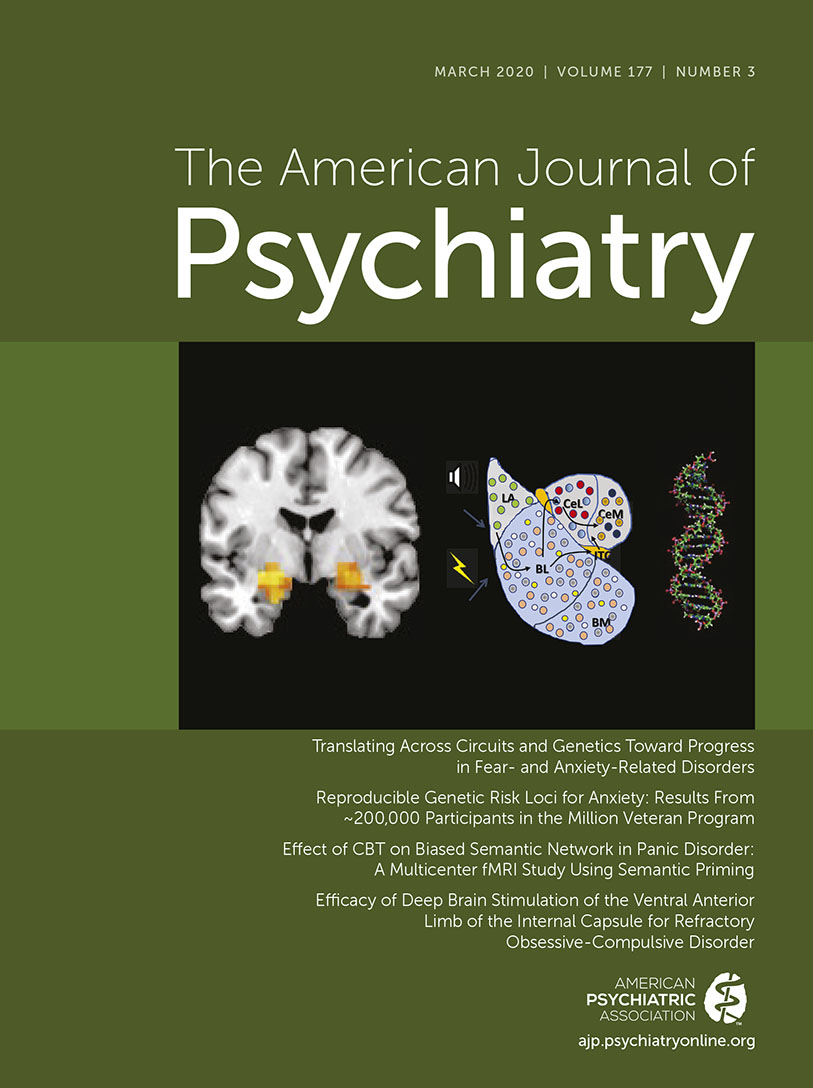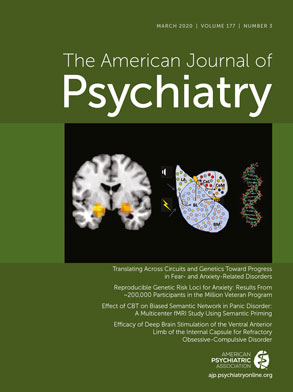A central goal of psychiatric neuroscience research is to identify the underlying neurobiological substrates of psychiatric disorders and their subtypes. This is a complicated endeavor, in that not all patients with a given disorder have the same clinical presentation, and such clinical heterogeneity could suggest different underlying biological substrates among individuals with the same condition. In the past 2 decades since the advent of functional MRI, many neuroimaging researchers have attempted to determine whether clinical phenotypes are associated with specific neural signatures using a “top-down” approach by first categorizing groups based on their symptom profiles and then comparing those groups in terms of activation in specific brain circuits. Using this top-down approach, researchers have compared cohorts with and without posttraumatic stress disorder (PTSD), but they also have compared subgroups of PTSD patients (e.g., those with reexperiencing responses to those with dissociative responses [
1,
2] and those with depression to those without depression [
3]). In the majority of these studies, researchers have constrained these between-group comparisons to a small number of specific, a priori brain regions or circuits that were of theoretical relevance to PTSD. For example, most early studies focused their statistical analyses on the amygdala and the medial prefrontal cortex because of their roles in fear learning and extinction, constructs that were deemed relevant to the etiology and/or maintenance of PTSD symptoms.
Although this top-down approach has been a pragmatic initial research approach, it remains possible, or even probable, that a given clinical phenotype may not directly map onto a single underlying neural substrate. In addition, the practice of constraining neuroimaging analyses to specific brain circuits carries with it a high risk of missing abnormalities in other brain circuits, which also could be important in the pathophysiology of PTSD.
An alternative approach in the attempt to examine associations between clinical phenotypes and underlying neurocircuitry reflects a more “bottom-up” process in which researchers examine patients’ patterns of brain activity and sort patients into groups according to the similarity of those patterns. The groups can then be compared on clinical, behavioral, demographic, or other measures, all of which can be assessed for clinical importance. For example, if it were found that a subgroup of PTSD patients with lesser functional connectivity within the salience network also responds more favorably to cognitive-behavioral treatment, then that neurophysiological subtype could be of potential clinical importance and would merit further study. Thus, the bottom-up approach could help identify novel, relatively homogeneous neurophysiological groups, which can be related to clinical phenotypes or outcomes that may have clinical utility. It should be noted that this general bottom-up approach includes dozens of methods that differ on many dimensions, including the extent to which the bottom-up analyses are constrained by limits imposed by the investigators.
In this issue of the
Journal, Maron-Katz et al. (
4) used bottom-up approaches in their effort to delineate neurophysiological subtypes of PTSD. The researchers searched for abnormal features in the resting-state functional MRI (rsfMRI) data of 87 veterans with PTSD, relative to 105 combat-exposed individuals without PTSD. Thus, the analyses were conducted taking the diagnostic groups (PTSD and non-PTSD) into account. From there, the authors grouped patients with PTSD according to similarity of their resting-state abnormalities. The analyses revealed two distinct PTSD subgroups: subgroup 1 (N=49) showed abnormally low connectivity between the visual and sensorimotor networks, and subgroup 2 (N=30) showed abnormally high connectivity between the visual and sensorimotor networks, as well as abnormally low connectivity between these two networks and the frontoparietal control network, and abnormally high connectivity within the frontoparietal control network. These two subgroups of PTSD patients were then compared on clinical, demographic, and behavioral measures. Subgroup 2 had greater severity of reexperiencing symptoms, a greater prevalence of comorbid traumatic brain injury (TBI), and tended to have slower reaction times than subgroup 1.
This study is important because it delineates a set of procedures that can be used to define neurophysiologically homogeneous subgroups within PTSD or in any other diagnostic group. It is an exciting first step in what will likely be a series of studies that will further characterize these subgroups of PTSD and determine what clinically important outcomes they might predict. As the authors noted, several questions remain to be addressed. First, given that the present sample consisted of predominantly male veterans, one might ask whether similar subtypes exist in women and/or in people who experienced other types of traumatic events. Given that some studies have revealed different patterns of functional connectivity in healthy women relative to men (
5), it is possible that connectivity subgroups may be different in cohorts of women with PTSD. Second, like many other well-controlled imaging studies of PTSD in the literature, the present study employed a trauma-exposed control group. It is intriguing to consider whether the findings would change if a trauma-unexposed healthy cohort were used as a control group. Resting-state connectivity differences between trauma-exposed individuals with and without PTSD could reflect either abnormalities related to PTSD or “abnormalities” related to resilience in the control group, or some combination of the two. Further research employing both trauma-exposed and trauma-unexposed control groups will be needed to sort that out. And third, it will be important to determine the extent to which the subgroups reflect differential TBI histories or perhaps differential vulnerability to TBI.
Arguably one of the most important questions to be asked is whether these two subgroups of individuals with PTSD differ in their response to treatment and/or clinical course. Furthermore, can the two different neurophysiological profiles be used to target treatments like transcranial magnetic stimulation to the aberrant network in each subgroup and thus improve treatment response for both subgroups? This possibility seems well worth exploring further.
When thinking about the prospect of using neuroimaging clinically, such as to subtype individual patients with PTSD, one must consider its accessibility and cost. If the two neurophysiological subgroups of PTSD are determined to be clinically useful, can they be distinguished with nonimaging proxy measures that are highly correlated with neurophysiological subtypes but are easier and less expensive to obtain than rsfMRI? For example, Maron-Katz et al. found that subgroup 2 tended to have slower reaction times as compared with both subgroup 1 and the control group. Further research might assess whether reaction times (or similar measures) can reliably distinguish the neurophysiological profiles on their own.
Although the present study was certainly not intended to interrogate the validity of the PTSD diagnosis, it may be worth considering the role that the DSM diagnostic criteria played in this and in other neuroimaging studies in psychiatry. In this study, diagnostic criteria were used to define the PTSD and control groups, constraining the bottom-up analyses. Thus, the neurophysiological subgroups may be limited by the validity of the DSM criteria used to define the larger PTSD group in the first place (
6–
8). That said, this comment applies to nearly all neuroimaging studies of PTSD. To address this issue, further research may employ “unsupervised” machine-learning methodology, whereby neurophysiological groups can be formed without imposing diagnostic constraints (
9).
In conclusion, the study by Maron-Katz et al. (
4) is noteworthy for its novel use of computational methods to define homogeneous neurophysiological subtypes of PTSD, and like most groundbreaking studies, it has generated many exciting and potentially clinically useful questions for future research to address.

